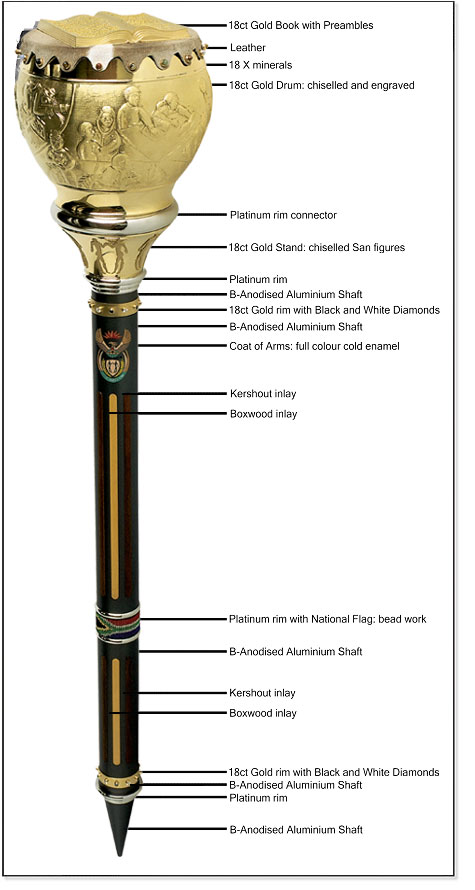The mace is a symbol of the authority of National Assembly. It is carried into the Chamber by the Serjeant-at-Arms and announces the arrival of the Speaker of the National Assembly. It signifies that the House is formally in session and that its proceedings are official.
Origin of the parliamentary mace
The mace has been used in its current ceremonial form in the House of Commons in England since the 16th century. The first mace used in the South African Parliament was a gold-plated replica of the House of Commons’ mace and was used in the House of Assembly of the Union of South Africa from 1910 to 1961. South Africa then became a republic and a stinkwood mace was used temporarily from 1961 to 1963.
The Gold Producers’ Committee of the Transvaal and Orange Free State Chamber of Mines then gave Parliament a gold mace, weighing 8,5 kg and 1,3 m in length. This mace was used until 2004 when, after a decision taken by the Rules Committee to look at the symbols of Parliament, a new mace was designed after a long consultation process. This mace was used for the first time during a sitting of the National Assembly on 14 September 2004.
A description of the mace

The new mace is 1,196 metres long and weighs 9,86 kilograms. It appears to be a single unit, but, in fact, it was made and fitted in sections on an aluminium core. At the head of the mace is an 18-carat gold drum covered in springbok skin which, in turn, is attached to the drum by 18 buttons made from South African minerals and gemstones. On top of the drum rests a book made from gold on which, in raised text, is an extract from the Preamble to the Constitution of the Republic of South Africa.
The drum is illustrated with images of South Africans going about their daily business, as a miner, saxophonist, machinist, architect, builder, soccer player, fork-lift driver, scientist, teacher, doctor, domestic worker, a woman with a baby on her back and a hoe in her hand, a woman driving a tractor and children reading and working. The images are designed to look like African woodcuts and were chiselled by hand to create a three-dimensional look. The images were then engraved for shading, texture and fine detail. It was the first time this kind of art had been transposed onto gold.
Once completed, the drum was fitted onto a gold neck illustrated with dancing San figures. Three platinum disks in decreasing size connect the head of the mace to the shaft. The shaft is made of aluminium, and inlaid with cherry and box wood. The top of the shaft is encircled by an 18-carat gold band, with six black and six white half-carat diamonds set into it.
Beneath this is the South African coat of arms, in full-colour enamel. Two-thirds from the top of the mace is a beaded South African flag. The white on the flag is represented by 800 platinum or white-gold beads, the yellow by 70 yellow gold beads, and the red, green, blue and black by coloured glass beads. Before the mace tapers to the end is another gold band of six black and six white diamonds and then another band of platinum.
Symbolism of the new mace
The new mace was designed to reflect the history, tradition, diversity, culture and languages of South Africa. The mace also celebrates the country’s natural beauty, its plant and animal life and its rich mineral resources. Each element was carefully chosen with this in mind.
The shape of the mace recalls the knobkerrie, an African symbol of defence, authority and leadership. The drum, which forms the head of the mace, is an expression of the African tradition of using drums to call people together for a meeting. It is also a reminder that South Africa’s transition to democracy was achieved through dialogue, with Parliament serving as a place where many different voices are heard.
Gold is one of the core ingredients in the mace. Archaeological finds show that gold has been mined and used in African culture for centuries. Its use in the mace symbolises the country’s natural wealth and also the ancient indigenous gold mining traditions.
The open book on the top of the drum symbolises the Constitution of South Africa and the principles around which Parliament functions. The Constitution is the supreme law of the country and plays a central role in the development of a new South Africa. This is echoed in its position at the top of the mace. The writing on the open pages of the book is the first line of the Preamble to the Constitution in each of the 11 official languages and one line from an extinct Khoisan language. The languages are presented alphabetically, starting with Afrikaans.
The platinum rings found at intervals along the shaft of the mace recall the rings worn by Ndebele women. Under the first set of platinum rings, at the base of the drum, is an image of two Khoisan taken from the Linton Stone, a world-famous example of South African rock art dating back at least 20 000 years. The image is a symbol of social interaction, coherence and interdependence, all elements needed for a country such as South Africa to grow and prosper.
The use of different materials and symbols on the mace were also chosen to represent the idea that the most advanced technology in the world can live harmoniously beside ancient traditional techniques. The result is a mace that recalls the past, mirrors the present and looks forward to the future.

